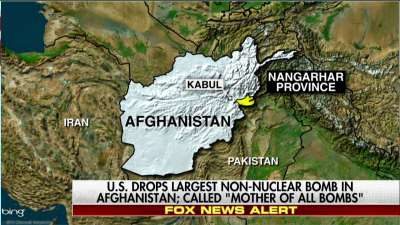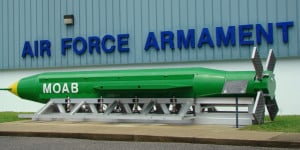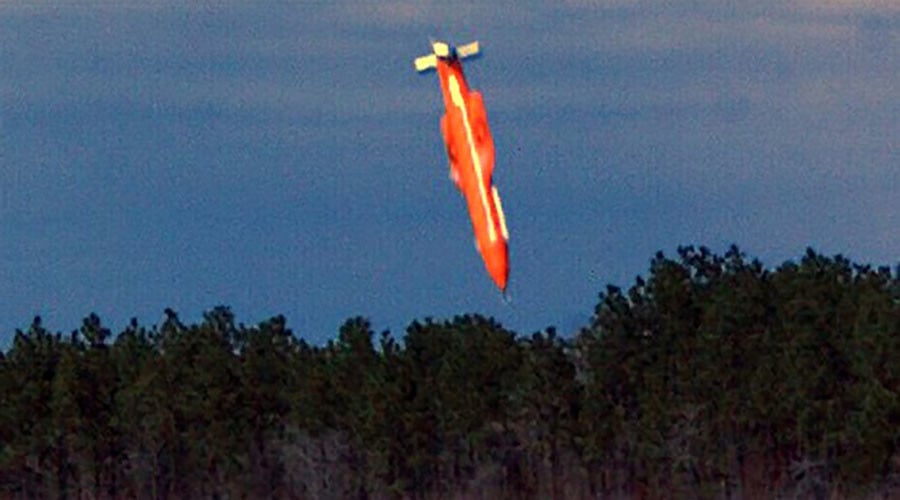The Pentagon’s “Mother of All Bombs” (MOAB) Dropped on Afghanistan (2017): Devastating Health Impacts, Ruined Farmland
In April 2017 the US Air Force dropped its most powerful non-nuclear bomb onto a Daesh stronghold in Nangarhar.

Almost two and a half years after the United States dropped the “mother of all bombs” onto a Daesh hideout in eastern Afghanistan, locals say they have been afflicted by “many diseases” and agricultural lands are not yielding crops.
TOLOnews reporter Abdulhaq Omeri interviewed residents of Mohmand Dara village, in the Achin district in the eastern province of Nangarhar.
Omeri witnessed many children and teenagers suffering from skin problems and listened to many residents speak of the bomb’s lasting effects.
In April 2017, US Forces dropped a GBU-43/B Massive Ordnance Air Blast (MOAB) on a Daesh stronghold of caves and tunnels in eastern Nangarhar province.
The bomb, nicknamed the “mother of all bombs” is one of the most powerful conventional (non-nuclear) weapons in the US arsenal, according to the US Department of Defense.
MOAB is a concussive bomb, meaning it detonates above ground rather than penetrating hardened defenses.
Anyone within 300 meters will be vaporized, experts say, while those in a one kilometer radius outside ground zero will be left deaf.
Nangarhar residents said the bomb has had a lasting effect on the area.
“The ‘mother of all bombs’ was dropped here,” said Pacha Shinwari, a local resident. “You can see that the stones can be broken easily, the plants are dry, the trees are dry, the nearby houses are all destroyed–40 or 50 of them.”
“The government evacuated the people (before the bomb was dropped), but when we came back, we saw that the houses were destroyed,” local resident Mohammadullah said.
Some teenagers are suffering from skin problems following the bomb explosion.
“Many diseases have emerged in this area after the bomb was used. Most of them have skin problems such as acne and skin irritations,” local resident Jam Roz said.
“The agricultural yields are not the same as in the past. The harvests are lesser than in the past,” said Aminullah, another resident.
Medical doctors and analysts interviewed by TOLOnews said the use of such bombs leaves an impact on areas where it is dropped.
“There are some concerns about the emergence of diseases after the use of the mother of all bombs in Achin, but so far the public health directorate has not recorded any disease that is related to the bomb,” said Zahir Adil, a spokesman for Nangarhar’s Directorate of Public Health.
“This bomb has three effects. First, it impacts the eyes. People will feel irritation in their eyes. Second, it impacts the inner organisms of the people who breathe the air where it has been used. It also impacts pregnant women and newborn babies… Afghanistan is a laboratory now. Third, it has an impact on lungs,” military affairs analyst Atiqullah Amarkhil said.
President Ashraf Ghani’s advisor and state minister for Human Rights and International Relations, Sima Samar, confirmed that the use of the MOAB in Nangarhar has had long-term effects on residents of Mohmand Dara village.
“It inevitably impacted the health of the Afghan people, especially in areas where explosives are used a lot, including the ‘mother of all bombs,’ which has left its mark on the lives of Afghans,” Samar said.
*
Note to readers: please click the share buttons above or below. Forward this article to your email lists. Crosspost on your blog site, internet forums. etc.
Featured image is from Tolo News



